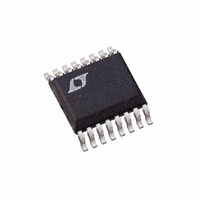LTC1756EGN Linear Technology, LTC1756EGN Datasheet - Page 14

LTC1756EGN
Manufacturer Part Number
LTC1756EGN
Description
IC SMART CARD 16-SSOP
Manufacturer
Linear Technology
Datasheet
1.LTC1756EGNPBF.pdf
(16 pages)
Specifications of LTC1756EGN
Applications
Smart Card
Voltage - Supply
2.7 V ~ 6 V
Package / Case
16-SSOP
Mounting Type
Surface Mount
Lead Free Status / RoHS Status
Contains lead / RoHS non-compliant
Interface
-
Other names
Q1274157
Available stocks
Company
Part Number
Manufacturer
Quantity
Price
Company:
Part Number:
LTC1756EGN
Manufacturer:
LT
Quantity:
10 000
Part Number:
LTC1756EGN
Manufacturer:
LINEAR/凌特
Quantity:
20 000
Company:
Part Number:
LTC1756EGN#PBF
Manufacturer:
ADI
Quantity:
46
Part Number:
LTC1756EGN#PBF
Manufacturer:
LINEAR/凌特
Quantity:
20 000
Part Number:
LTC1756EGN#TRPBF
Manufacturer:
LINEAR/凌特
Quantity:
20 000
APPLICATIO S I FOR ATIO
LTC1755/LTC1756
Overtemperature Fault Protection
An overtemperature circuit disables the chip and activates
the ALARM pin if the IC’s junction temperature exceeds
150 C.
Self-Start Mode
By connecting the CARD pin to the PWR pin, the LTC1755/
LTC1756 can be made to start up automatically when a
Smart Card is detected (Figure 6). In this mode, the READY
pin becomes an interrupt signal indicating to the micro-
controller that a Smart Card is present and that V
charge pump voltage, is at its final value. The Smart Card
remains powered as long as it is detected by the PRES pin.
When the Smart Card is removed the LTC1755/LTC1756
will automatically be deactivated by the fault detection
circuitry.
Deactivation Sequence
For maximum flexibility the Smart Card can be deactivated
either manually or automatically. In manual mode the de-
activation is controlled by explicitly manipulating the
LTC1755/LTC1756 input and control pins (DATA, AUX1IN,
AUX2IN, RIN and CIN followed by PWR and CS). In auto-
matic mode the PWR pin is used to perform the built-in
14
AUX2
AUX1
RST
CLK
V
I/O
CC
I/O = DATA
RST = R
CLK = C
Figure 7. Deactivation Sequence
DEACTIVATION DIRECTIVE
CARD
Figure 6. Self-Start Mode
IN
IN
U
READY
PWR
U
1755 F06
TO
MICROCONTROLLER
W
U
1755 F07
CC
, the
deactivation sequence. Once PWR is brought high the built-
in deactivation sequence occurs as shown in Figure 7.
In the event of a fault, the LTC1755/LTC1756 automatically
implement the built-in deactivation sequence.
PC Board Layout
For best performance, the V
be placed as close to the LTC1755/LTC1756 as possible.
This will help reduce ringing due to inductance on the V
and V
LTC1756 control circuitry or Smart Card. Figure 8 illus-
trates a possible layout technique using only a single layer
of the PC board.
State Definitions
IDLE/DEACTIVATION
V
READY, ALARM, DATA, AUX2IN, AUX1IN = Z
CARD = PRES
Once the LTC1755/LTC1756 enter the Idle/Deactivation
state the deactivation sequence begins. The deactivation
sequence will continue until V
mately 1V. An activation command (PWR = 0V) will only be
acknowledged once this occurs.
ALARM/DEACTIVATION
Same as Idle/Deactivation except:
ALARM = L
CC
, RST, CLK, I/O AUX2, AUX1 = L
CC
Figure 8. Optimum Bypass Capacitor Placement
pins that could cause problems with the LTC1755/
GND
V
IN
NC/NO
V
CC
IN
CC
and V
is discharged to approxi-
CC
capacitors should
17556 F08
IN










